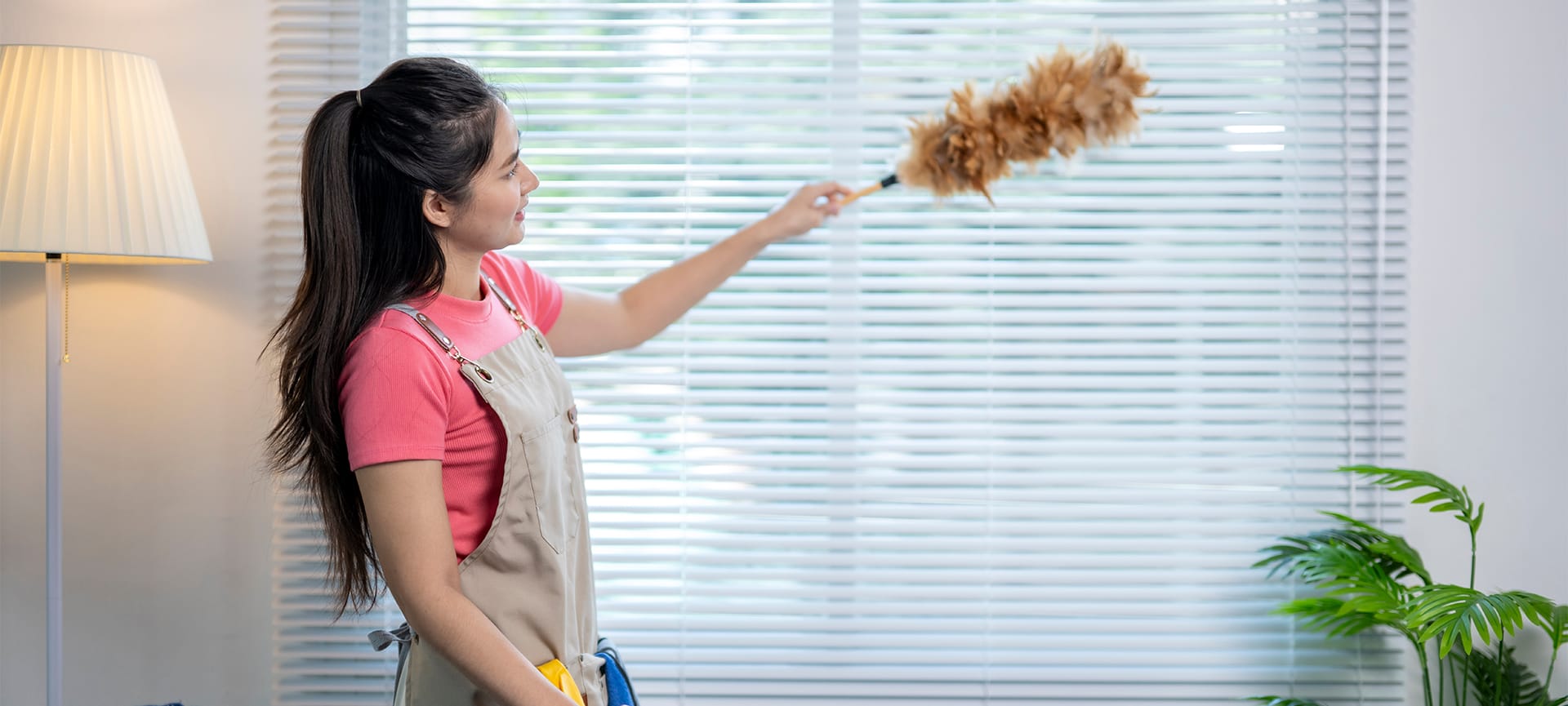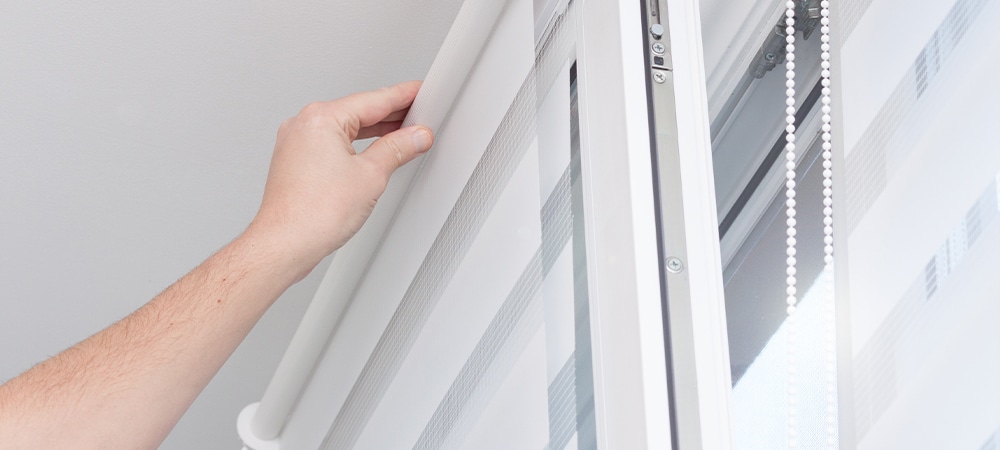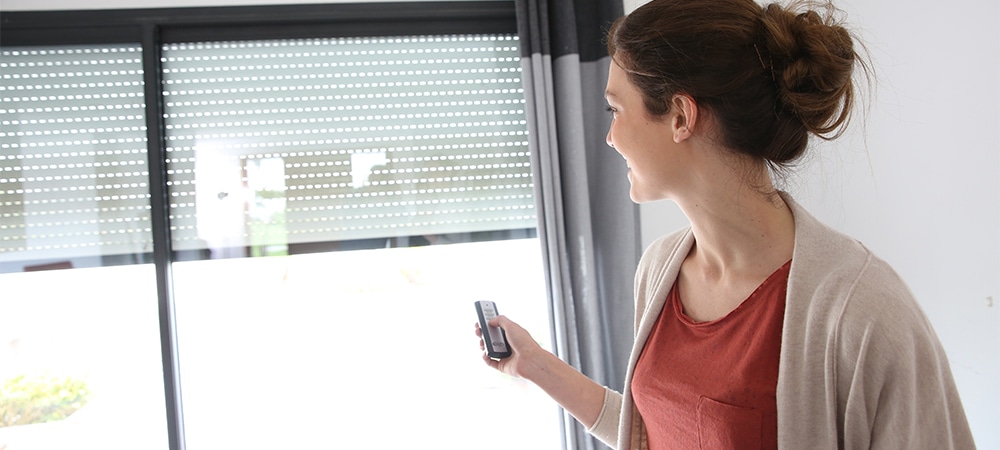How to Maintain and Clean Different Types of Blinds
Imagine a room bathed in natural light, the air crisp and clean. Yet, a closer look reveals a layer of dust clinging to your blinds, compromising the very atmosphere you’re trying to create. Clean blinds are not just about aesthetics; they contribute to a healthier living or working environment.
In this guide, we’ll delve into the art of cleaning and maintaining various types of blinds, ensuring your window treatments remain both beautiful and functional.
Related Article: The Role of Blinds in Energy Efficiency at Home
General Cleaning Tips for All Blind Types
Before we dive into specific cleaning methods for different blind types, let’s establish some fundamental cleaning principles that apply to all.
Dusting
A quick and regular dusting routine is the cornerstone of blind maintenance. By gently wiping down your blinds weekly, you can prevent the accumulation of dust and dirt, which can diminish their appearance and compromise indoor air quality.
Cleaning Solutions
When cleaning your blinds, it’s essential to use gentle, non-abrasive cleaning solutions. Avoid harsh chemicals that can damage the fabric or hardware. A simple mixture of warm water and mild dish soap is often sufficient.
Cleaning Specific Blind Types
Below, we’ll guide you through effective cleaning practices for some of the most common blind types.
Horizontal Blinds (Venetian Blinds)
For regular maintenance, use a soft, dry cloth, feather duster, or microfibre cloth to gently remove dust and light debris from each slat, as microfibre cloths are particularly effective at trapping dust rather than spreading it.
For more stubborn dirt or stains, dampen a soft cloth with a mild cleaning solution and wipe each slat individually, being careful not to over-saturate the material. Ensure the slats are dried thoroughly afterwards to prevent water damage or warping, especially for wooden blinds.
How to Clean Vertical Window Blinds
Vertical Blinds
To clean vertical blind vanes, start by closing the blinds fully to access one side and use a feather duster, soft brush, or microfibre cloth to gently remove dust and debris. Work from the top of each vane downward to prevent dust from resettling, then flip the vanes to clean the other side. For deeper cleaning, particularly for stains or stubborn dirt, dampen a soft cloth with a mild cleaning solution and wipe each vane individually.
Avoid soaking the material, as excessive moisture can weaken fabric vanes or warp vinyl or plastic ones. Allow the vanes to air dry completely before using the blinds again to prevent mould or mildew.
Cleaning the Track and Headrail
Use a damp cloth or sponge to wipe these areas thoroughly, paying special attention to grooves and moving parts where dirt accumulates. For hard-to-reach spots, a soft toothbrush or small brush can effectively dislodge dirt.
Roller Shades
To keep roller shades clean and well-maintained, regularly dust the fabric using a soft brush, microfibre cloth, or a vacuum cleaner with a brush attachment. Fully extend the shade and work in sections from top to bottom to ensure thorough coverage. For delicate or textured fabrics, a microfibre cloth helps prevent snagging. For deeper cleaning, check the manufacturer’s care instructions as methods can vary.
If spot cleaning is allowed, mix a mild detergent with warm water, dip a clean cloth in the solution, wring it out, and gently blot stains or dirt spots, avoiding scrubbing to prevent damage or discolouration. Some shades may be removable and safe for hand washing or machine washing on a gentle cycle.
Cleaning the Roller Mechanism
Dust and grime can accumulate on the roller mechanism over time, affecting its smooth operation. To clean it, wipe down the mechanism with a damp cloth, taking care not to let water seep into the roller. If the mechanism is sticky or difficult to operate, apply a small amount of silicone-based lubricant to ensure seamless rolling. Avoid using oil-based lubricants, as they can attract more dirt.
How to Clean Fabric Window Blinds
If you’re wondering how to clean cloth window blinds effectively, regular dusting and gentle spot cleaning with a mild detergent can help maintain their appearance and longevity. Below are detailed steps to ensure your cloth blinds stay fresh and functional.
Roman Shades
Regularly dust the fabric with a soft brush, microfibre cloth, or vacuum cleaner with a brush attachment. Fully extend the shades and clean in sections from top to bottom, paying extra attention to the folds where dust and debris often accumulate.
For minor stains, mix a small amount of mild detergent with warm water, dampen a clean cloth, and gently blot the affected area, avoiding excessive scrubbing to prevent damage or discolouration. Rinse the spot with a clean, damp cloth and blot dry with a towel to remove excess moisture.
Related Article: Roller Shades vs. Roman Shades
Zebra Blinds
Learning how to clean window blinds fabric properly involves using the right techniques, such as dusting regularly and spot cleaning with a gentle detergent to preserve the material’s quality. Fully extend the blinds to access all sections evenly, and work in a downward motion to prevent spreading dust to already-cleaned areas.
For minor stains or smudges, dampen a clean cloth with a mild detergent solution and gently blot the affected area, avoiding scrubbing to prevent damage or fraying. Rinse with a cloth dampened in plain water and pat dry with a clean towel, being careful not to over-saturate the fabric, as the sheer material in zebra blinds can warp or stretch when wet.
Related Article: How to Clean Zebra Blinds
Motorized Blinds
Basic Cleaning and Maintenance:
- Dusting the Blinds: Regularly dust the blinds using a soft cloth, microfibre duster, or vacuum cleaner with a brush attachment. Dust accumulation can affect the appearance and, in some cases, the movement of the blinds, so focus on cleaning both the slats and the edges.
- Cleaning the Remote Control and Sensors: Dust and dirt can also accumulate on the remote control, wall switches, or sensors. Use a slightly damp cloth to gently wipe these surfaces. Ensure that no moisture enters the buttons or electronic components to prevent damage.
- Avoiding Harsh Chemicals: Avoid using abrasive cleaners or harsh chemicals, as these can damage the finishes or affect electronic functionality. For stubborn stains, a mild soap solution applied with a soft cloth is usually sufficient.
- Moisture Control: Excessive moisture can damage the fabric or electronic components of motorized blinds. Use damp (not wet) cloth sparingly, and ensure all cleaned areas are thoroughly dried to prevent water damage or corrosion.
Troubleshooting Common Issues:
- Motor Malfunctions: If the motorized blinds fail to move or respond to commands, check for obstructions along the track or on the blinds themselves. Obstructions can block the mechanism or prevent sensors from functioning properly.
- Battery Problems: For battery-operated motorized blinds, ensure that the batteries are charged or replaced as needed.
- Software Glitches: For motorized blinds connected to smart home systems or apps, software glitches can occasionally occur. Restart the system or app and ensure your device’s firmware is updated.
- Professional Assistance: If troubleshooting steps fail to resolve the issue, contact a professional technician or the manufacturer’s service team. Attempting complex repairs without expertise can void warranties or damage the blinds further.
Preventing Mould and Mildew
To keep your blinds looking their best and prevent the growth of mould and mildew, it’s important to maintain a clean and dry environment. Here are a few tips:
- Regular Cleaning: As mentioned earlier, regular cleaning is crucial to remove dust, dirt, and moisture.
- Proper Ventilation: Ensure adequate ventilation in your home or office to reduce humidity levels.
- Avoid Excess Moisture: Avoid exposing your blinds to excessive moisture, such as from leaky pipes or spills.
- Sunlight Exposure: Sunlight can help to kill mould and mildew, so open your blinds regularly to allow natural light to penetrate your space.
Professional Cleaning
While regular cleaning can keep your blinds looking their best, there may be times when professional cleaning is necessary. Consider professional cleaning if:
- Your blinds are heavily soiled or stained.
- You have difficulty reaching high-up blinds.
- Your blinds are made of delicate materials that require specialized cleaning techniques.
A professional cleaning service can deep-clean your blinds, removing dirt, grime, and allergens. They can also inspect your blinds for any damage and provide necessary repairs.
The Benefits of Regular Blind Maintenance
By following these simple cleaning and maintenance tips, you can keep your blinds looking their best and functioning optimally. Regular cleaning enhances the aesthetic appeal of your space and improves air quality and overall well-being.
For professional cleaning or maintenance services, contact Blinds Toronto. Our team can help you keep your blinds looking pristine and functioning flawlessly.
Remember, a little care goes a long way. By prioritizing regular blind maintenance, you can enjoy cleaner, healthier, and more beautiful spaces for years to come.

Just another writer from downtown Toronto. I have worked as a window salesman and a blinds installer so I have a great amount of knowledge in this industry.
Favourite Downtown Restaurant: Lee’s
Blinds of choice: Zebra Blinds
Feel free to share my blogs if you find them useful.


